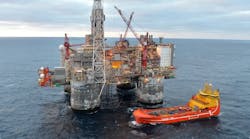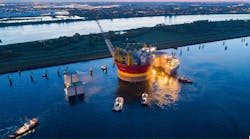Editor's note: This story first appeared in the November-December 2022 issue of Offshore magazine. Click here to view the full issue.
By Bruce Beaubouef, Managing Editor
Since February, European governments and utilities have made up much of the Russian shortfall by purchasing supplies of liquefied natural gas from overseas sources, and by building new infrastructure to access gas produced from the North Sea and offshore Norway.
To facilitate the LNG import plans, a number of European nations are deploying floating storage and regasification units (FSRUs) that will tie into new or existing LNG terminals. According to Global Energy Monitor’s Europe Gas Crisis Tracker, there are currently plans for 26 LNG terminals, terminal expansion projects, and associated FSRU deployments for ten European countries, 22 of which have been announced, proposed, or revived since February 2022. These projects would boost import capacity by at least 152 billion cubic meters per year.
As part of these plans, Europe has secured 12 FSRUs, and plans to deploy an additional nine to tie into the LNG terminal infrastructure. Some of the key developments are highlighted below.
Germany
As the largest industrial economy in Europe, Germany has been most active in ramping up its LNG imports and deploying FSRUs to facilitate that process. This past summer it was announced that four floating storage and regasification units were planned for deployment offshore Germany along with two permanent onshore sites, with an emphasis upon the FSRUs to help secure near-term and medium-term gas supplies.
The German government earmarked 2.94 billion euros ($3.07 billion) for the projects, set to be developed by utilities RWE and Uniper, respectively. The government chartered four FSRUs, two via Uniper and two via RWE. Germany’s economy ministry says that it hopes to begin operations at two FSRUs – one at Wilhelmshaven and one at Brunsbuttel – before the end of 2022. The port city of Hamburg, as well as Rostock on the Baltic Sea, have also been suggested as possible locations for an FSRU.
In August, Germany signed a memorandum of understanding with Uniper, RWE, and EnBW’s VNG to ensure that the FSRUs in Wilhelmshaven and Brunsbuettel will be fully supplied from their expected operational start this winter until March 2024. Using the two FSRUs, Germany will be able to receive up to 12.5 Bcm of LNG per year, about 13% of the country’s gas demand in 2021.
Germany has also been working to secure LNG supplies. Officials have held talks with Qatar and Canada on the potential for LNG supply deals, while utilities EnBW and RWE are also eyeing long-term deliveries of LNG from the United States.
In September, Germany announced plans for a fifth FSRU deployment. The German Federal Ministry of Economics and Climate Protection (BMWK) announced that Tree Energy Solutions (TES), E.ON and ENGIE had been selected to jointly develop and implement the project. Scheduled for a 2023 commissioning, this fifth FSRU will have an annual import capacity of about 5 Bcm, equal to about 5% of Germany’s annual gas consumption.
ENGIE is responsible for chartering the FSRU on behalf of the BMWK, and TES is responsible for its development and operation. The five-year-chartered FSRU will be provided by Excelerate Energy, and will be stationed in Wilhelmshaven, where TES already owns 145 hectares of land. The TES terminal’s structure will ultimately include six ship berths, 2 MMcm of onshore storage using 10 onsite tanks, and direct access to the natural gas, hydrogen and CO2 pipeline networks required for the nation’s decarbonization plans.
The Netherlands
Meanwhile, The Netherlands has announced plans to deploy two FSRUs to enhance its gas security. This past summer, Gasunie subsidiary EemsEnergyTerminal signed the first contracts for supply of LNG via the port of Eemshaven in the Netherlands. The Czech power company Čez and Shell Western LNG B.V. have jointly contracted 7 Bcm of capacity.
Dutch Minister for Climate and Energy Policy Rob Jetten commented that, with Gasunie’s efforts, the LNG capacity in the Netherlands will be expanded significantly this year.
“That is an important part of our approach to becoming less dependent on Russian gas as soon as possible, but also to preparing for the coming winter,” Jetten said. “I am pleased that there is considerable market interest in making use of this infrastructure and importing more liquid gas.”
Until this year, the Netherlands only had an LNG terminal at the port of Rotterdam. The expansion in the Eemshaven port and the optimization of the terminal in Rotterdam will double the nation’s LNG import capacity.
The LNG terminal in the port of Eemshaven will consist of two FSRUs: the Exmar S188 and the Golar Igloo. Both vessels arrived at the port in early September, and the Exmar S188 was renamed as the Eemshaven LNG. The LNG tanker Murex, loaded at Cheniere Energy Inc.’s Sabine Pass project on the US Gulf Coast, arrived on Sept. 8 to deliver the first LNG cargo to the Eemshaven terminal.
Together, the two FSRUs have a throughput capacity of approximately 8 Bcm per year, which officials say can contribute significantly to ensuring the security of supply and reducing dependence on Russian gas. Over the next five years, the FSRUs at the port of Eemshaven will convert LNG back into its gaseous form. The terminal will also be able to store LNG.
Italy
Italy is also looking to supplement its gas supply with LNG and FSRUs. In September, DNV reported that it had advised Snam Group on its acquisition of two FSRUs for operations offshore Italy. Snam acquired the Golar Tundra from Golar LNG and the BW Singapore from BW Gas Cyprus, with DNV performing the buyer’s technical and environmental due diligence in both cases.
The two vessels can operate as FSRUs and LNG carriers. Each one has an LNG storage capacity of 170,000 cubic meters of LNG and a nominal continuous regasification capacity of 5 Bcm/year. Their combined capacity should cover about 15% of Italy’s yearly gas needs.
Snam plans to station the Golar Tundra off central-northern Italy, starting operations as an FSRU in spring 2023, subject to regulatory approvals and construction of the infrastructure needed to connect the terminal to the existing gas transport network.
In addition, Golar LNG has announced it will repurpose the LNG carrier Golar Arctic as an FSRU that will operate offshore Sardinia for Snam.
Greece
In Greece, plans are also being made for an FSRU deployment that will tie into a new gas pipeline system. In September, it was announced that Italian certification company RINA and Greek engineering consultancy Asprofos will provide project management consultancy services for the Alexandroupolis Independent Natural Gas System, which will be owned and developed by Gastrade. The facilities will comprise a permanently moored FSRU and a 28-km pipeline system connecting the vessel to the Greek national natural gas transmission system.
The FSRU will be stationed in the northeastern Aegean Sea, 17.6 km southwest of Alexandroupolis in northeast Greece. The vessel will have a storage capacity of 153,500 cubic meters, a nominal gas send out rate of 625,000 cubic meters/hour and a peak (without redundancy) gas send-out rate of up to 944,000 cubic meters/hour. The companies say that the FSRU is expected to commence operations by year-end 2023.
Baltic Pipe
Baltic Pipe has been recognized as a project of common interest to the European Union, and a strategic infrastructure project that will create a new European gas supply corridor. The project was developed by the Danish gas and electricity transmission system operator Energinet and the Polish gas transmission system operator Gaz-System.
Baltic Pipe started flowing some gas to Polish consumers in late September, but full commissioning of the system has been delayed due to technical issues at the reception terminal in Nybro, Denmark. After this phased startup, the full system is set to be operational in 4Q 2022.
Energy islands
Operating as “green power plants at sea,” the Danish Energy Agency says they will serve as hubs to connect wind turbines to electricity grids in the region surrounding the two seas. The idea is that hundreds of wind turbines will be linked up to these artificial islands allowing Denmark to generate much more energy than with other offshore wind projects.
Together, the two islands will be able to power at least five million European homes with the potential to expand to 10 million in the future. They were originally set to be operational by 2030, but Denmark is now looking to reduce its reliance on fossil fuels faster in the wake of the war in Ukraine.








